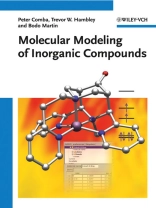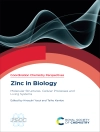After the second edition introduced first density functional theory aspects, this third edition expands on this topic and offers unique practice in molecular mechanics calculations and DFT. In addition, the tutorial with its interactive exercises has been completely revised and uses the very latest software, a full version of which is enclosed on CD, allowing readers to carry out their own initial experiments with forcefield calculations in organometal and complex chemistry.
สารบัญ
PART I: Theory
INTRODUCTION
Molecular Modeling
Historical Background
MOLECULAR MOEDLING METHODS IN BRIEF
Molecular Mechanics
Quantum Mechanics
Other Methods
PARAMETERIZATION, APPROXIMATIONS AND LIMITATIONS OF MOLECULAR MECHANICS
Concepts
Potential Energy Functions
Force-Field Parameters
Spectroscopic Force Fields
Model and Reality
Electronic Effects
The Environment
Entropy Effects
Summary
COMPUTATION
Input and Output
Energy Minimization
Constraints and Restraints
THE MULTIPLE MINIMA PROBLEM
Deterministic Methods
Stochastic Methods
Molecular Dynamics
Practical Considerations
Making Use of Experimental Data
CONCLUSIONS
PART II: Applications
STRUCTURAL ASPECTS
Accuracy of Structure Prediction
Molecular Visualization
Isomer Analysis
Analysis of Structural Trends
Prediction of Complex Polymerization
Unraveling Crystallographic Disorder
Enhanced Structure Determination
Comparison with Solution Properties
STEREOSELECTIVITIES
Conformational Analysis
Enantioselectivities
Structure Evaluation
Mechanistic Information
METAL ION SELECTIVITY
Chelate Ring Size
Macrocycle Hole Size
Preorganization
Quantitative Correlations Between Strain and Stability Differences
Conclusions
SPECTROSCOPY
Vibrational Spectroscopy
Electronic Spectroscopy
EPR Spectroscopy
NMR Spectroscopy
QM-Based Methods
ELECTRON TRANSFER
Redox Potentials
Electron-Transfer Rates
ELECTRONIC EFFECTS
d-Orbital Directionality
The trans Influence
Jahn-Teller Distortions
BIOINORGANIC CHEMISTRY
Complexes of Amino Acids and Peptides
Metalloproteins
Metalloporphyrins
Metal-Nucleotide and Metal-DNA Interactions
Other Systems
Conclusions
ORGANOMETALLICS
Metallocenes
Transition Metal-Allyl Systems
Transition Metal-Phosphine Compounds
Metal-Metal Bonding
Carbonyl Cluster Compounds
COMPOUNDS WITH S-, P-, AND F-BLOCK ELEMENTS
Alkali and Alkaline Earth Metals
Main Group Elements
Lanthanoids and Actinoids
Conclusions
PART III: Practice of Molecular Mechanics
THE MODEL, THE RULES, AND THE PITFALLS
Introduction
The Starting Model
The Force Field
The Energy Minimization Procedure
Local and Global Energy Minima
Pitfalls, Interpretation, and Communication
TUTORIAL
Introduction to the Momec3 Program
Building a Simple Metal Complex
Optimizing the Structure
Building a Set of Conformers
Calculating the Strain Energies and Isomer Distribution of a Set of Conformers
Constructing and Optimizing a Set of Isomers Automatically
Building More Difficult Metal Complexes
Analyzing Structures
Potential Energy Functions I: Bond Length, Valence Angle, Torsion Angle, Twist Angle, and Out-of-Plane Deformation Functions
Potential Energy Functions II: Non-Bonded Interactions
Force-Field Parameters I: Developing a Force Field for Cobalt(III) Hexaamines –
Normal Bond Distances
Force-Field Parameters II: Refining the New Force Field –
Very Short Bond Distances
Force-Field Parameters III: Refining the New Force Field –
Very Long Bond Distances
Force-Field Parameters IV: Comparison of Isomer Distributions Using Various Cobalt(III) Amine Force Fields
Force-Field Parameters V: Parameterizing a New Potential –
The Tetrahedral Twist of Four-Coordinate Compounds
Using Constraints to Compute Energy Barriers
Using Constraints to Compute Macrocyclic Ligand Hole Sizes
Cavity Sizes of Unsymmetrical Ligands
Using Strain Energies to Compute Reduction Potentials of Coordination Compounds
Using Force-Field Calculations with NMR Data
Optimizing Structures with Rigid Groups
APPENDIX 1: Glossary
APPENDIX 2: Fundamental Constants, Units, and Conversion Factors
Constants
Basic SI Units
Derived Units and Conversion Factors
Energy Units in Molecular Mechanics Calculations
APPENDIX 3: Software and Force Fields
APPENDIX 4: Books on Molecular Modeling and Reviews on Inorganic Molecular Modeling
List of Books on Molecular Modeling
List of Reviews in the Field of Inorganic Molecular Modeling
List of Publications on the Momec Force Field
+ CD with full software version and tutorial supplements
เกี่ยวกับผู้แต่ง
Peter Comba is Professor of Inorganic Chemistry at the University of Heidelberg, Germany. He obtained his Ph.D. in 1981 from the University of Neuchatel, Switzerland. After postdoctoral positions at the Australian National University and the University of Lausanne and the habilitation at the University of Basel, he moved in 1992 to Heidelberg. He received the Humboldt South Africa Research Award in 2000 and had visiting professorships at the Universities of Leiden, ANU, Pretoria, Brisbane and Osaka. His research includes theory and experiments in transition metal coordination and bioinorganic chemistry – molecular modeling, spectroscopy, magnetochemistry, thermodynamics, kinetics and mechanisms, synthesis and catalysis.
Trevor Hambley is Full Professor at The University of Sydney, Australia. He received his Ph.D. in 1982 from the University of Adelaide, followed by a postdoctoral stay the Australian National University. He received the Edgeworth David Medal in 1989 and awards for Research Supervision and Teaching in 1997, 1998, and 2008. His research interests are focused on hypoxia and tumour selective agents, Pt anti-cancer drugs, matrix metalloproteinase targeting agents, and drug design and development.
Bodo Martin is a computational chemist with Peter Comba at the University of Heidelberg. He obtained his Ph.D. in organic chemistry in 2004 from the University of Erlangen, Germany in the group of Tim Clark. His research includes the application of quantum chemical methods, semi-empirical method development (polarizabilities, dispersion), molecular mechanics development and computer science.












